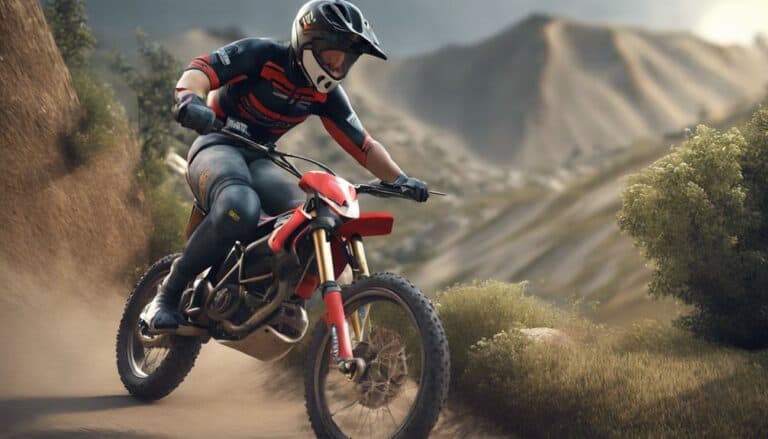When faced with a sudden downpour during your ride, how should you adjust your braking technique to assure safety and control on wet roads?
Understanding the nuances of weight distribution and tire traction in varied conditions is key. By exploring how these factors interplay with your braking system, you can optimize your approach for different terrains.
In the quest for mastering braking skills, every rider must navigate the intricacies of adapting techniques to diverse riding environments.
Key Takeaways
- Adapt braking pressure to terrain for control and safety
- Modulate brake pressure for improved grip and versatility
- Utilize engine braking for stability and wear reduction
- Adjust braking distance for varied conditions to prevent skidding
Understanding Different Terrain Surfaces
When riding in varying terrain conditions, it's important to adapt your braking technique to guarantee top control and safety. Understanding how to utilize your rear brake effectively is vital for maneuvering different surfaces.
On loose or sandy terrain, gently apply both front and rear brakes to prevent skidding and maintain control.
When riding on rocky or uneven surfaces, rely more on your rear brake to avoid the front wheel from getting stuck or becoming unstable.
Grass or gravel surfaces require a smooth and gradual braking approach to avoid losing traction and sliding.
In wet or muddy conditions, reducing braking force and increasing your following distance can help prevent hydroplaning or sliding.
Additionally, adjusting your braking technique on icy or snowy terrain by lightly using both brakes and focusing on balance is key to staying stable.
Mastering the use of your rear brake in various terrain types will enhance your riding experience and ensure safety.
Modulating Brake Pressure
To maintain control and traction on varying terrain, it's essential to adjust your brake pressure based on the trail gradient. Proper brake modulation is vital for safety, especially on steep descents, to prevent skidding.
When riding on slippery surfaces like mud or ice, consider using lighter brake pressure to improve grip and avoid sliding. Conversely, on dry, firm trails, increasing brake pressure gradually can help you slow down effectively without losing control.
Mastering the art of varying brake use is key to adapting to different riding conditions. Practice different brake pressure techniques to become more versatile and confident in your riding. Remember, the way you modulate your brakes can make a significant difference in how well you navigate challenging terrains. By honing your skills in brake modulation, you enhance your ability to handle diverse surfaces and ensure a safer and more enjoyable riding experience.
Utilizing Engine Braking Effectively
Engine braking, a technique utilizing the resistance of the engine to decelerate the motorcycle, can be a valuable asset for riders seeking to enhance control and reduce wear on braking components. When used effectively, engine braking can provide smoother deceleration and increased stability, especially in challenging riding conditions.
To make the most of engine braking, consider the following:
- Downshift Appropriately: Downshifting to lower gears increases the resistance provided by the engine, allowing you to slow down without relying solely on the brakes. This can help in reducing wear on brake pads and discs over time.
- Enhanced Control: Properly timed downshifting not only slows down the motorcycle but also aids in maintaining better control over your speed and trajectory. This can be particularly useful when maneuvering sharp turns or steep descents.
- Safety in Slippery Conditions: Engine braking can be a safer alternative to braking in slippery or low-traction situations, where sudden braking may lead to skidding. By utilizing engine braking effectively, you can enhance your riding safety and control in various environments.
Adjusting Braking Distance
Adjust your braking distance according to the specific riding conditions you encounter to guarantee safe and controlled stops. In wet or slippery conditions, it's important to increase your following distance and brake earlier than usual. This adjustment allows for longer stopping distances and reduces the risk of skidding.
When riding on rough or uneven terrain, apply the brakes gradually to prevent skidding and maintain control over the bike. For downhill descents, utilize both the front and rear brakes to control your speed without losing traction.
In sandy or loose gravel surfaces, rely more on the rear brake to prevent the front wheel from washing out and maintain stability. At high speeds, anticipate your braking distances and apply the brakes progressively to avoid locking up the wheels.
Practicing Emergency Braking Techniques
Incorporate a variety of surfaces and weather conditions into your regular practice of emergency braking techniques to enhance your preparedness for real-world riding scenarios. When practicing emergency braking, pay special attention to the use of your rear wheel to optimize stopping power and maintain control.
Here's how you can effectively practice emergency braking techniques:
- Focus on progressive pressure: Apply gradual pressure on both brakes, paying attention to the rear wheel, to prevent locking up and skidding.
- Simultaneous brake application: Utilize both front and rear brakes together while keeping the bike upright to maximize stopping efficiency.
- Adapt to traction conditions: Develop the skill of quickly adjusting brake pressure on the rear wheel based on the surface for better traction and control during sudden stops.
Conclusion
To sum up, mastering braking techniques for different riding conditions is vital for safety and control on the road. By understanding terrain surfaces, modulating brake pressure, utilizing engine braking, adjusting braking distance, and practicing emergency techniques, you can ride confidently in any situation.
Remember, practice makes perfect, so keep honing your skills to become a master of the road. And always remember, Rome wasn't built in a day – take your time to perfect your braking skills for a smoother ride.

